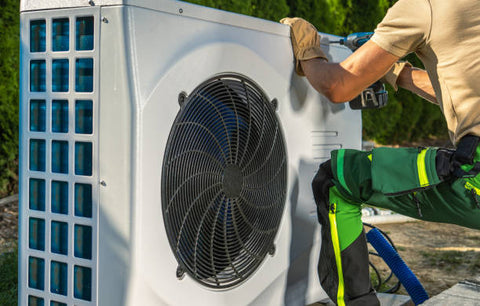Selecting and sizing a heat pump for your heating and cooling needs is a critical decision. An appropriately sized and chosen heat pump will ensure optimal performance, energy efficiency, and long-term comfort. In this guide, we will explore the essential steps to correctly size and select a heat pump system for your home or business.

Understanding Heat Pump Sizing
Sizing a heat pump involves determining the appropriate capacity (measured in British Thermal Units or BTUs) required to maintain a comfortable indoor temperature. Selecting the right size is crucial, as an undersized heat pump will struggle to meet your heating and cooling needs. At the same time, an oversized unit may cycle on and off frequently, resulting in poor efficiency and temperature inconsistencies.
Steps for Heat Pump Sizing and Selection
Calculate Heating and Cooling Load
Start by calculating the heating and cooling loads of your space. Factors to include the size of the area, insulation levels, local climate, and any unusual heat sources (e.g., large windows, appliances).
Determine the Required BTUs
Use the calculated load to determine the required BTUs. This figure will serve as a baseline for selecting the heat pump's capacity.
Select the Appropriate Type of Heat Pump
Choose between air-source, ground-source (geothermal), or water-source heat pumps based on factors like your location, available space, and budget.
Consider the Climate
The local climate plays a vital role in heat pump selection. In colder regions, choose a model with a higher Heating Seasonal Performance Factor (HSPF) for better efficiency.
Energy Efficiency Ratings
Look for heat pumps with high Seasonal Energy Efficiency Ratio (SEER) ratings for cooling and HSPF for heating. Higher ratings indicate better energy efficiency.
Professional Assessment
Seek the assistance of an HVAC professional to perform a Manual J calculation. This detailed analysis considers all factors and ensures the heat pump is sized correctly.
Zoned Heating and Cooling
Consider zoning your space to achieve more precise temperature control. This allows you to install a smaller heat pump for better efficiency.
Brand and Model Selection
Research and compare different brands and models. Read reviews, check for reliability, and choose a unit that suits your budget and performance needs.
Installation Quality
Ensure that your heat pump is professionally installed. Proper installation is crucial for the unit's efficiency and longevity.
Common Sizing Mistakes to Avoid
Guesswork: Never guess the heat pump size based solely on the square footage of your space. Many other factors come into play.
Oversizing: Avoid the temptation to select a larger heat pump, thinking it will provide better comfort. Oversized units are less efficient.
Neglecting Climate Considerations: Pay attention to the local climate, especially if you live in a region with extreme temperatures. A heat pump's performance can vary significantly based on climate.
Conclusion
Selecting and sizing a heat pump requires careful consideration of factors such as the load, climate, efficiency ratings, and professional input. An appropriately sized and chosen heat pump will ensure a comfortable and energy-efficient indoor environment. Investing time and effort in the selection process will pay off with long-term comfort, lower energy bills, and reduced environmental impact. For a successful outcome, always consult with an HVAC professional to ensure your heat pump is perfectly sized for your specific needs.

